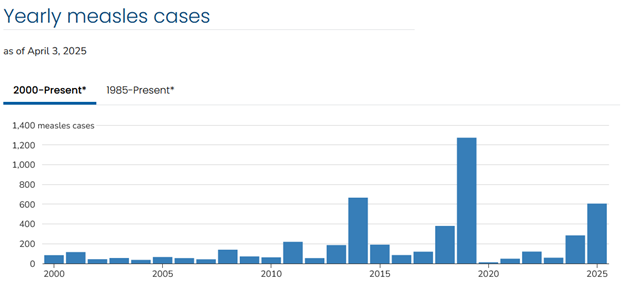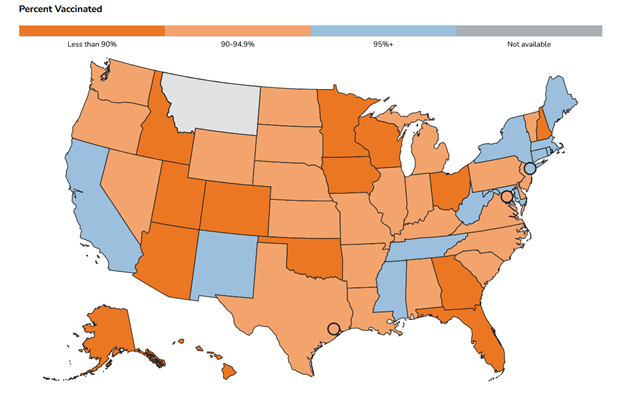Online Course
NRSG 780 - Health Promotion and Population Health
Module 11: Infectious Diseases
Transmission
Infectious diseases arise from the complex interactions between the agent, host and environment.
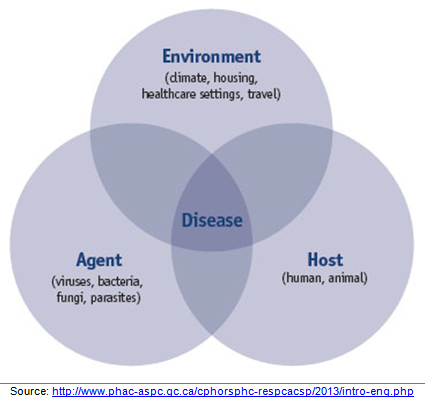
Transmission occurs when the agent leaves its reservoir or host through a portal of exit, is conveyed by some mode of transmission, and enters through an appropriate portal of entry to infect a susceptible host. This sequence is referred to as the chain of infection.
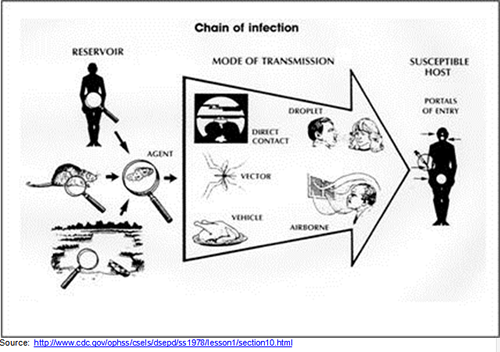
Agent/Pathogen—virus, bacterium or parasite that causes the disease in humans
Reservoir—place where the agent lives and multiplies in the environment or another human or animal species
Portal of Exit/Mode of Transmission—how the agent travels from one host to another (aerosols, sexual contact, body fluids, blood-borne) or from a reservoir to a new host (inanimate objects or vectors e.g. insects, food, water
Portal of Entry—how the agent enters a new host (aerosols, fecal-oral, skin, mucous membranes, blood)
Susceptible host— depends on genetic or constitutional factors, specific immunity or non-specific factors that protect against infection, e.g., skin, mucous membranes, gastric acidity, respiratory cilia or nonspecific immune response, and factors that increase susceptibility to infection, e.g., malnutrition, alcoholism or disease or therapy that impairs the nonspecific immune response
Understanding the portals of exit and entry and modes of transmission serves as the basis for determining control measures which are often directed toward the segment in the chain of infection that is most susceptible to intervention and include:
- Controlling or eliminating agents at their source of transmission
- Protecting portals of entry
- Increasing host resistance
Major Infectious Disease Threats
Many factors contribute to the growth and spread of infectious diseases:
- Global travel
- Urbanization
- Immigration
- Housing
- Health care practices
- Public health infrastructure
- Food production and preparation
- use and misuse of antibiotics
- microbial adaptation
- human behavior
These factors, compounded by the ability of micro-organisms to evolve and adapt to changing populations, environments, practices and technologies, create ongoing threats to health and continually challenge efforts to prevent and control infectious diseases.
Case Study: Herd Immunity and the Increase in Measles Cases
Herd Immunity—Describes how a population is protected from a disease after vaccination by stopping the infectious agent from being transmitted between people. Sufficiently high levels of herd immunity can indirectly protect individuals who cannot be vaccinated.
The level of herd immunity needed to protect the population varies by the contagion level of the disease. Measles is highly contagious and to achieve herd immunity requires at least 90-95% of the population to be vaccinated. Polio is less contagious and to achieve herd immunity requires 80-85% of the population to be vaccinated.
On average, approximately 92.7% of children in the US are vaccinated against measles but rates vary considerably by state and communities within states.
CDC reports that misinformation about the safety of the measles/mumps/rubella (MMR) vaccine is significant factor contributing to the outbreak of measles and that organizations are deliberately targeting communities with inaccurate and misleading information about vaccines. CDC recommends that parents discuss vaccination with their children’s health care providers and encourages health professionals and local leaders to provide accurate and scientific information to counter misinformation.
CDC MMR Vaccine Coverage for Kindergarteners for School Year 2024
The most common reasons given to US health care professionals by families who refuse to vaccinate their children are as follows:
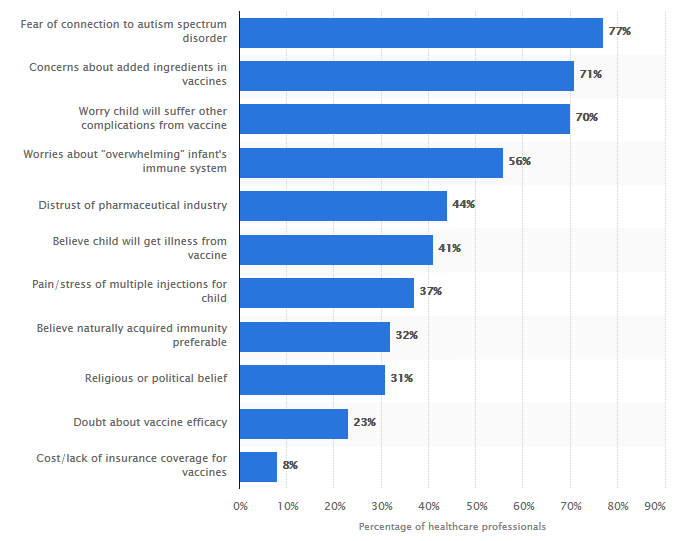
The WHO identifies vaccine hesitancy as one of the ten leading threats to global health stating the complacency, inconvenience in access, and a lack of confidence in the vaccine are key factors that have led to a resurgence of diseases such as measles in countries that were close to eliminating them. For more information click on https://www.statista.com/topics/5166/vaccine-hesitancy-in-the-us/.
This website is maintained by the University of Maryland School of Nursing (UMSON) Office of Learning Technologies. The UMSON logo and all other contents of this website are the sole property of UMSON and may not be used for any purpose without prior written consent. Links to other websites do not constitute or imply an endorsement of those sites, their content, or their products and services. Please send comments, corrections, and link improvements to nrsonline@umaryland.edu.
